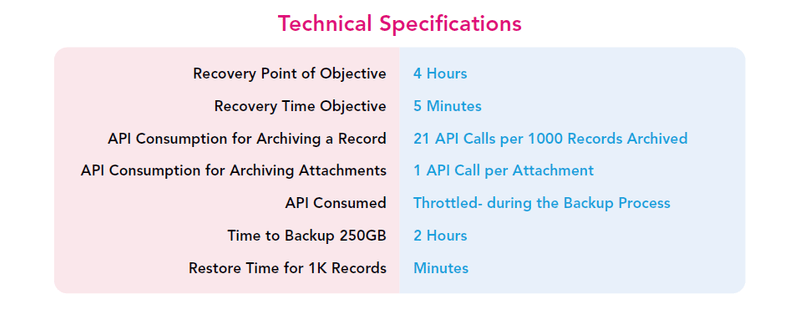Today, data loss is inevitable.
According to Gartner, by 2022, 70% of organizations will suffer a business disruption due to unrecoverable data loss in a SaaS application.”
Businesses worldwide face a variety of data loss scenarios, including everyday threats such as migration errors, bad code, malicious intent, data overwrites and even advanced external threats like cyberattacks and ransomware. Businesses need to know that data loss in today’s digital business will happen.
As your Salesforce enterprise becomes more data-driven, it is imperative to have a Salesforce data backup and recovery strategy to protect data assets. Your enterprise data, whether it’s your company’s intellectual property or sensitive confidential client information, is your organization’s biggest asset. If these are not managed properly, they can become a significant liability.
A Salesforce data backup strategy is a key pillar to secure your data and make your systems fail-proof. We talked to customers and security experts to provide you with a list of key trends when developing your Salesforce data backup strategy:
Boost confidence with Salesforce Data Backup Recovery readiness
Your Salesforce data backup service is only as good as what it can recover. The ability to take higher backup levels is great, but what will really matter is whether the Salesforce data backup apps will show recoverability.
Enterprises will need to have recovery readiness and a great way to measure it is to establish a recovery readiness index. Instant data recovery needs to be immediately accessible.
The ability to create frequent incremental copies that capture data changes as well merges differential backups with full backups without losing content and context is imperative.
Leveraging Data Beyond Salesforce Data Backup
The secret to Tesla’s success is its ability to leverage time-series sensor data into a machine-learning algorithm to improve self-driving car functionality.
Similarly, business insights and predictive analytics can help reveal critical insights from your data. While data backup and archival are the low-hanging fruits, the next-gen Salesforce data backup service will also need to offer over and beyond a rapid recovery.
Rather than let the data sit idle, you can use it to your strategic advantage. From using the backup data for analytical purposes, performing data breach vulnerability assessments, patch testing or providing data copies for DevOps purposes, the need to make data accessible automatically and securely will be a growing trend in the year ahead.
Continuous Data Protection with Automation
Continuous Salesforce data backup apps leverage automation to ensure data backup is automatic, secure, and error-free. Thus, you can have a backup every time a change is made rather than at scheduled time intervals. This ensures that if disaster strikes, you have all your data up to that exact point.
This requires you to discuss various recovery scenarios with your disaster recovery team or disaster as a service partner. Ticking all the right check boxes in the checklist ensures that you are well prepared to meet any data breach or intrusion. Using artificial intelligence to prioritize data recovery or archiving will further expand the role of automation in backup and recovery.
Data Recovery-As-A-Service
Solution providers in the backup and recovery space will increasingly adopt DRaaS (Disaster Recovery as a Service) as low-code cloud computing applications gain significance among enterprises and growing businesses.
Poised to grow at a CAGR of 41.6% from 2021 to 2027, we expect it to increase significantly to USD 38.91 billion by 2027. Even as it eliminates the burden of backup and disaster recovery in-house, DRaaS also ensures that businesses have access to comprehensive data protection and recovery to minimize IT downtime or disruption.
Flosum: 100% Native Salesforce Data Backup and Recovery

The Salesforce data backup and recovery landscape are going through a radical shift while still trying to meet the traditional obligations of backup and data recovery.
Choosing a native Salesforce backup solution that innovates ahead of this curve allows you to leverage Salesforce’s inherent strength to locate and recover data at blazing fast speeds.
Flosum Data Backup and restore features automated or scheduled backups, data comparison, full or partial restore options, and enables organizations to stay GDPR and CCPA compliant.
It is engineered to set up easily and work seamlessly within the DevOps processes so that teams can work efficiently without risking their organization’s assets.





